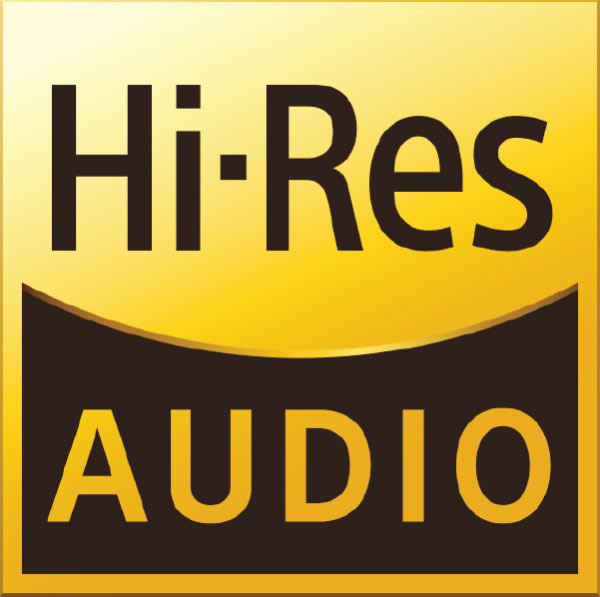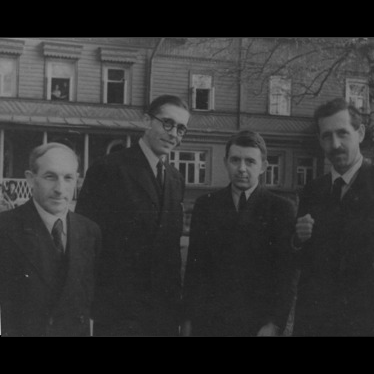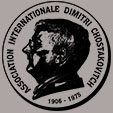Étiquette : NYPO
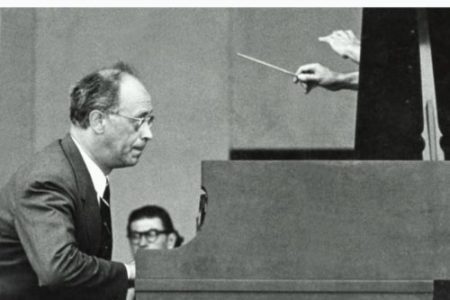
Rudolf Serkin – Dimitri Mitropoulos NYPO
Carnegie Hall – October 23, 1955
Source: Bande/Tape 19 cm/s / 7.5 ips
Pour les concerts de gala (avec de nombreux invités) fêtant la rentrée de l’orchestre après une longue tournée européenne (3 septembre – 7 octobre 1955), Rudolf Serkin et Dimitri Mitropoulos ont joué les 20 & 21 octobre 1955 trois Concertos de Mozart, successivement le n°25 K.503, le n°16 K.451 donné pour la première fois avec le NYPO, et le n°23 K.488. Les critiques ont été éminemment favorables, mais plusieurs ont remarqué que, si, quand le pianiste jouait, l’orchestre était réduit à de justes proportions mozartiennes, par contre, l’orchestre seul jouait avec le plein effectif de cordes, engendrant dans les tutti lourdeurs, problèmes d’équilibre et excès de dynamique.

Le plein effectif des cordes avec ses neuf contrebasses! (P-H Lang N-Y Herald Tribune Oct.21,1955)
Des critiques ont souligné que, pour un tel concert d’ouverture, le chef n’aurait pas pu faire autrement qu’employer ce plein effectif.
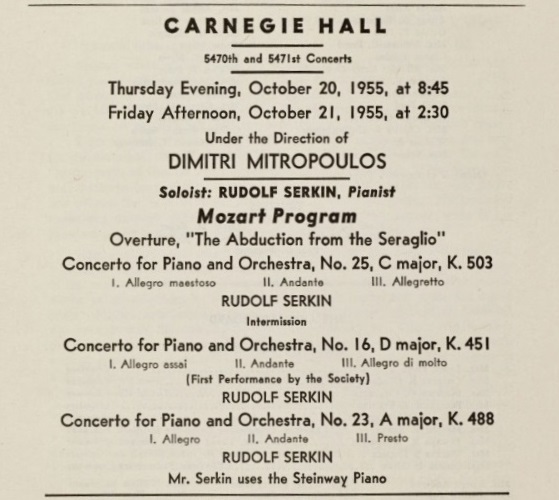
Le programme du concert radiodiffusé du dimanche 23 ne retenait que les Concertos n°16 & 25, mais s’ouvrait par la Sinfonia Concertante « K. Anh.104 » de Mozart:
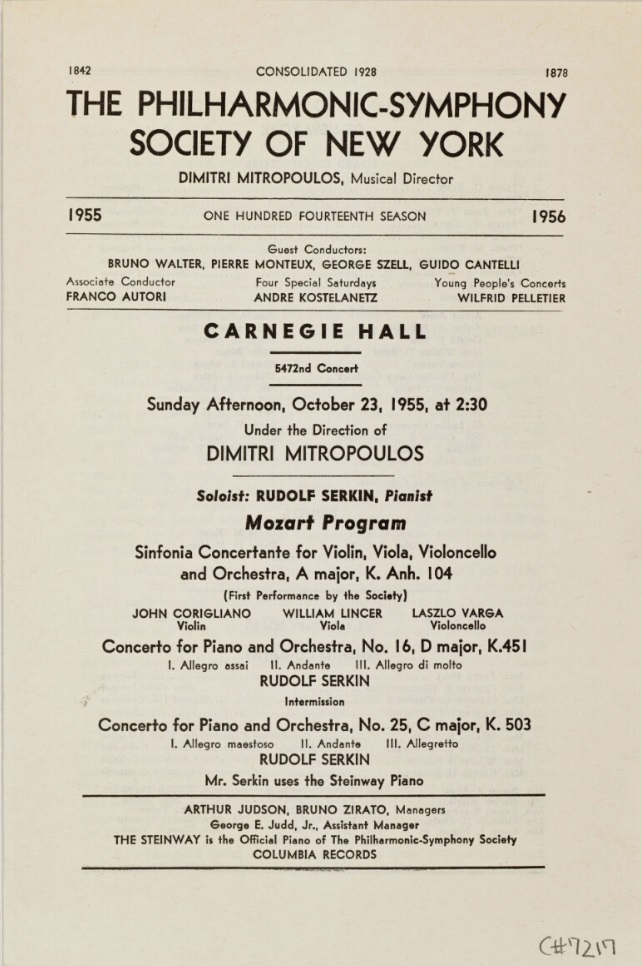
Sunday Afternoon Broadcast with only two Concertos played by Rudolf Serkin
For the gala opening concerts (with many guests) to celebrate the orchestra after its long European tour (September 3 – October 7, 1955), Rudolf Serkin and Dimitri Mitropoulos performed three Concertos by Mozart on October 1955, 20 & 21, successively n°25 K.503, n°16 K.451 (first performance with the NYPO), and n°23 K.488. The critics were quite favourable, but several of them remarked that, if in solo passages, the orchestra had the size of a Mozart ensemble, however the orchestra alone performed with a full complement of strings, thus with problems of heaviness, balance shifts and excessive dynamics in tutti. Critics underlined that, for such an opening concert, the conductor could not do otherwise than to display the full body of strings. Of these, only Concertos n°16 K.451 and n°25 K.503 were played at the Sunday Afternoon Broadcast concert, which opened with Mozart’s Sinfonia Concertante « K. Anh.104 ».
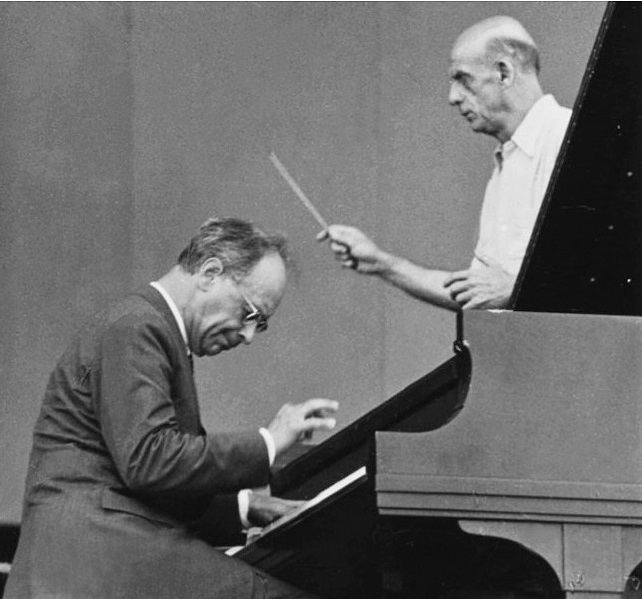
Les liens de téléchargement sont dans le premier commentaire. The download links are in the first comment.
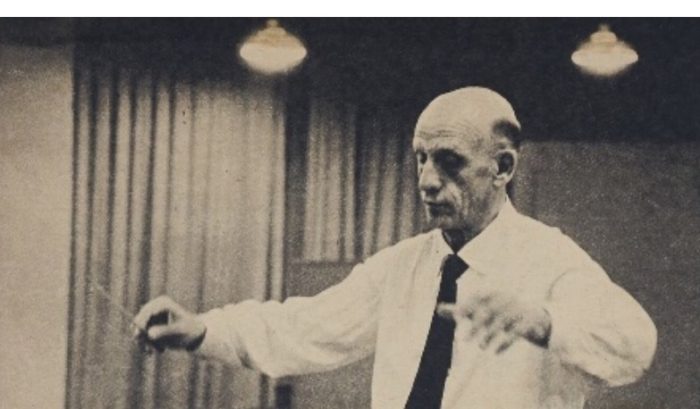
Dimitri Mitropoulos New York Philharmonic
Columbia 30th Street Studios – 24 février 1957
Bande 19 cm/s 2 pistes (7.5 ips ; 2 tracks) OMB – 6
Nous poursuivons cet Hommage à Dimitri Mitropoulos (1896-1960) à l’occasion du 125ème anniversaire de sa naissance. D’ici la fin de l’année, quatre autres publications vont suivre.
Février 1957, c’était pour Columbia le début de la stéréo. Le 18 février Bruno Walter commença à Carnegie Hall l’enregistrement de la Deuxième Symphonie de Mahler qu’il ne pourra terminer que l’année suivante. Pour cette Symphonie Fantastique, nous sommes dans les Studios Columbia de la 30ème rue, une ancienne église arménienne, qui a été utilisée depuis fin 1948 pour un très grand nombre d’enregistrements de musique de chambre et d’orchestre. La prise de son stéréophonique, très soignée, assume une esthétique sonore qui vise au spectaculaire, ce qui fonctionne parfaitement avec cette œuvre. L’interprétation, comme toujours très personnelle, de Mitropoulos est une réussite. Notons que le chef l’avait donnée au concert à Carnegie Hall les jeudi 21 et vendredi 22 février, et l’enregistrement a été réalisé le dimanche 24.
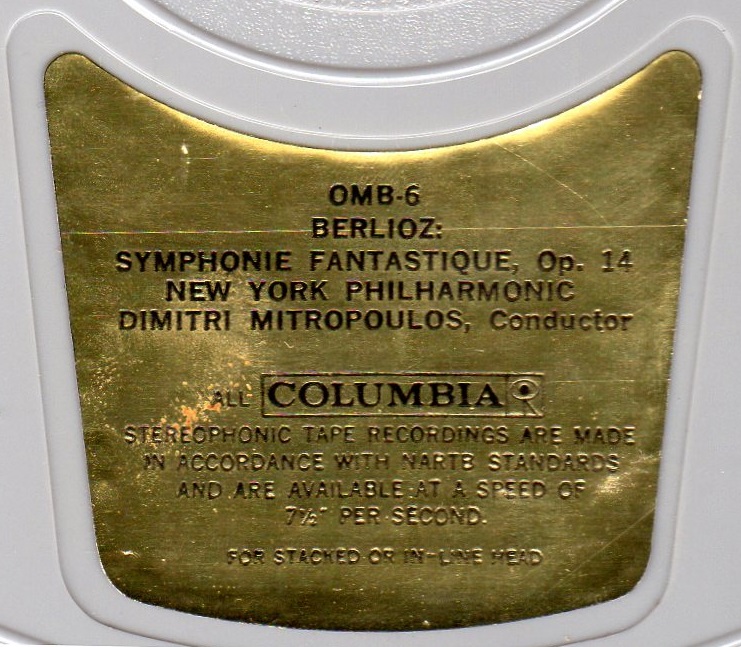

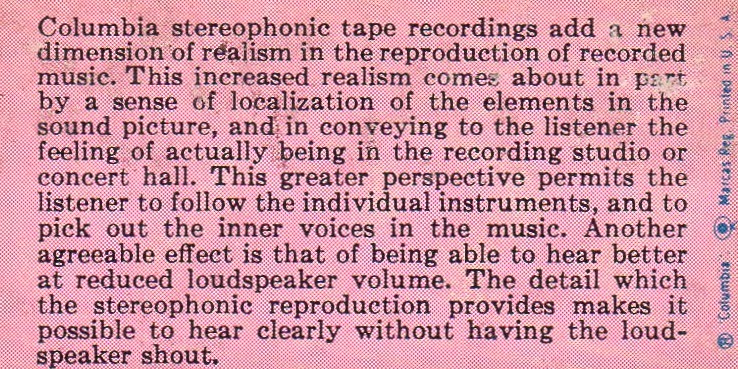
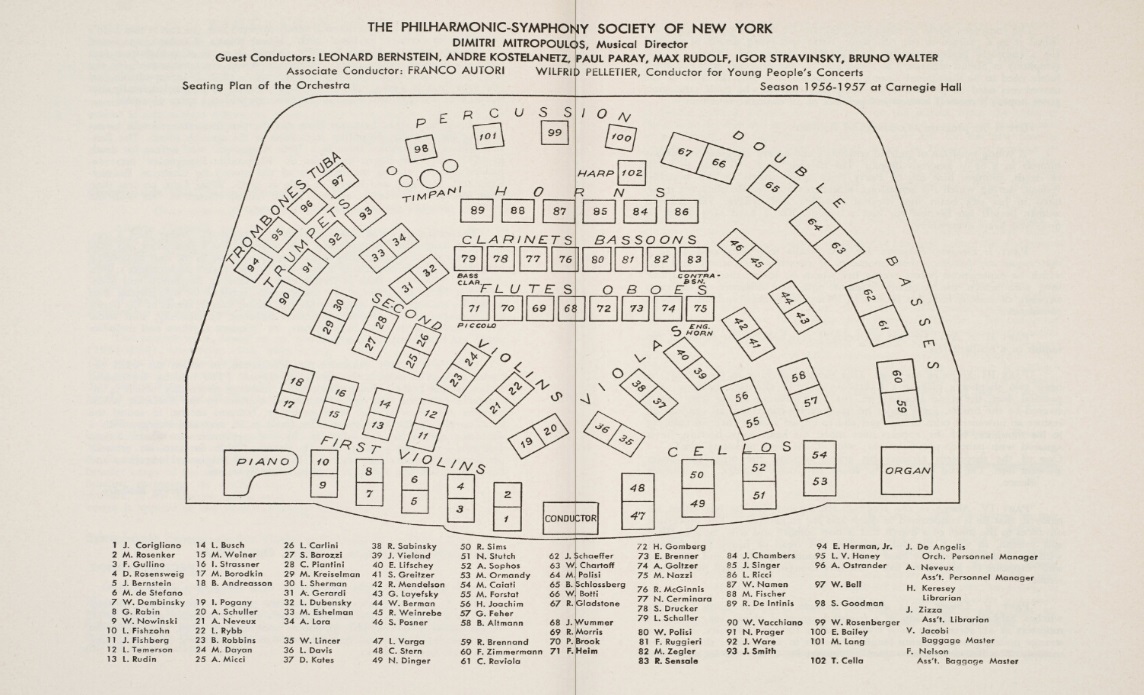
Disposition de l’orchestre à Carnegie Hall (saison 1956-1957)
We go on with this Tribute to Dimitri Mitropoulos (1896-1960) for the 125th Anniversary of his birth. Until the end of this year, four more posts will follow.
February 1957 was for Columbia the beginning of Stereo. On February 18, Bruno Walter began in Carnegie Hall the recording of Mahler’s Second Symphony which he was able to complete only the following year. For this Symphonie Fantastique, we are in the Columbia 30th Street Studios, a former Armenian church, which was used since the end of 1948 for a very large number of chamber music and orchestral recordings. The stereophonic recording, very carefully done, displays a chosen sound spectacular aesthetics, which matches this work perfectly well. The performance, very personnal, as always with Mitropoulos, is a winner. Note that the conductor performed it at Carnegie Hall on Thursday 21 and Friday 22, and the recording was made on Sunday, the 24th.
Les liens de téléchargement sont dans le premier commentaire. The download links are in the first comment.

New York Philharmonic Bruno Walter
Carnegie Hall – 24 Janvier 1954
Source: Bande/Tape 19 cm/s / 7.5 ips
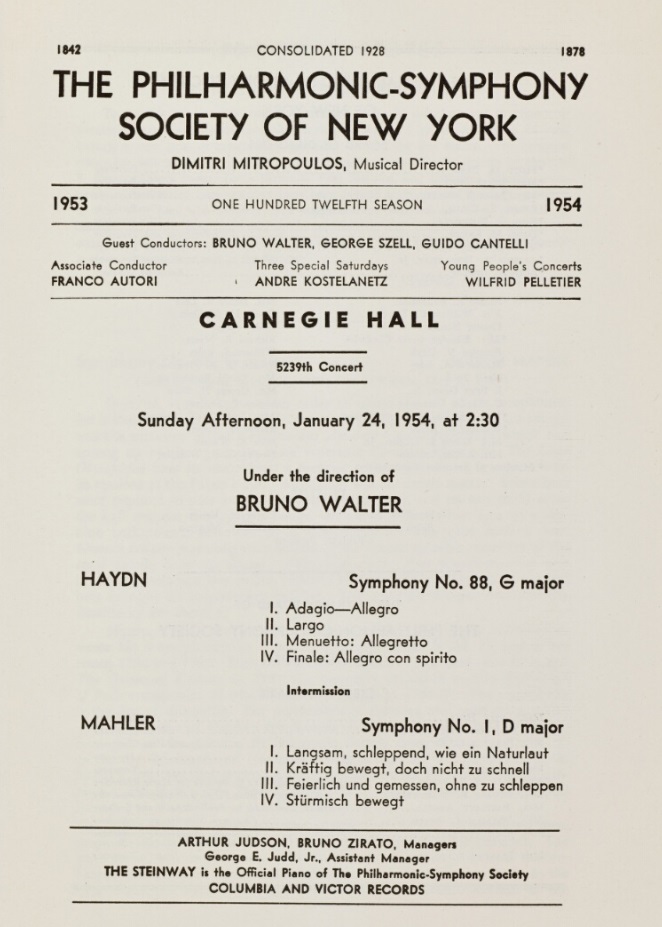
Bruno Walter a dirigé plusieurs fois cette symphonie avec le NYPO, et ce dès 1924 (les 28 et 29 février). Il la dirigea de nouveau en octobre 1933 (les 12, 13, 14, et 15), en octobre 1942 (les 22, 23, 24 et 25), en février 1950 (les 9, 10 et 12) et enfin une seule et unique fois en 1954, pour le concert radiodiffusé du dimanche 24 janvier depuis Carnegie Hall, suivi le lendemain par l’enregistrement pour Columbia dans cette même salle (plutôt que dans l’ habituel « Columbia 30th Street Studio »). Le concert public est plus vivant que sa contrepartie pour le disque. On remarque, à l’écoute de l’enregistrement du concert, une certaine sécheresse de l’acoustique de Carnegie Hall, que l’on ne perçoit pas dans la salle vide où le disque a été capté.
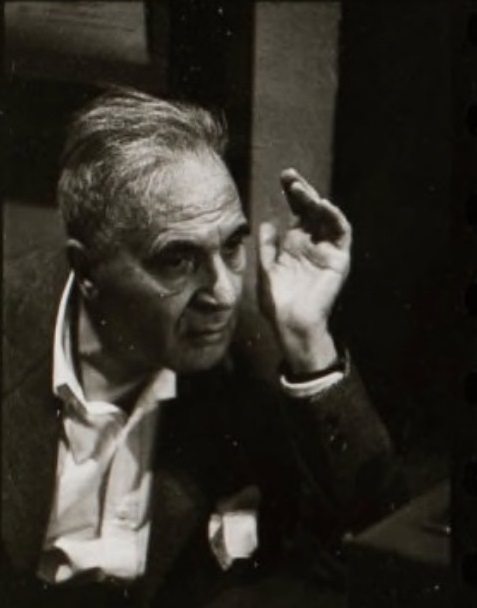
Bruno Walter conducted several times this symphony with the NYPO, as early as 1924 (February 28 and 29). He conducted it again in October 1933 (12, 13, 14, and 15), in October 1942 (22, 23, 24 and 25), in February 1950 (9, 10 and 12) and only once and for the last time in 1954, for the Sunday broadcast Concert of January 24 from Carnegie Hall, followed on the next day by the recording for Columbia in the same venue (rather than the usual « Columbia 30th Street Studio »). The live performance is more lively than its disc countertpart. When listening to the broadcast concert, one notes some dryness in the acoustics of Carnegie Hall, not to be found in the empty hall where the disc has been recorded.
Les liens de téléchargement sont dans le premier commentaire. The download links are in the first comment.
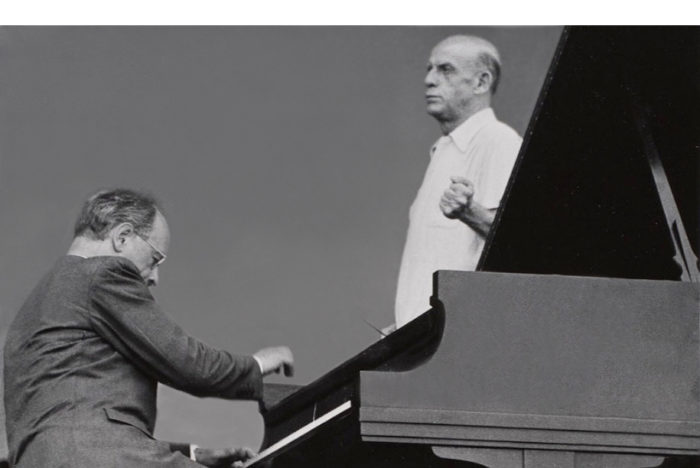
Rudolf Serkin – Dimitri Mitropoulos NYPO
Carnegie Hall – 31 octobre 1948 – Violoncelle solo: Leonard Rose
Source: Bande/Tape 38 cm/s / 15 ips
Entre le Concert du 20 février 1936 (Beethoven Concerto n°4 Op.58 & Mozart Concerto n°27 K.595 avec Arturo Toscanini) et le « Rudolf Serkin Golden Jubilee Program » du 20 février 1986 (Beethoven Concerto n°4 Op.58 avec Zubin Mehta), Rudolf Serkin a joué plus de 110 fois avec le NYPO, dont 27 Concerts sous la direction de Dimitri Mitropoulos, mais aucun disque avec ce dernier n’en est résulté. Ce rare enregistrement du Concerto n°2 de Brahms représente leur première collaboration avec le NYPO. L’interprétation est d’une rare intensité et il est donc tentant de la comparer avec la célèbre version Edwin Fischer/Wilhelm Furtwängler dont le style est bien sûr très différent.
(Enregistré sur disques 33 tours 40 cm à gravure directe, reportés ensuite sur bande magnétique).
_________________
New York Philharmonic – Concerts avec/with Rudolf Serkin & Dimitri Mitropoulos
(Carnegie Hall sauf indication contraire / Carnegie Hall unless otherwise indicated)
– Oct. 28, 29 & 31, 1948 Brahms Concerto n°2 Op.83
– Jan. 5, 6, 1950 Reger Concerto Op.114
– Jan. 7, 8,1950 Beethoven Concerto n°4 Op.58
– Nov. 13, 1950 Mozart Rondo K.382; Schumann Introduction & Allegro Op.134 (US Premiere), Mendelssohn Concerto n°1 Op.25; Strauss Burleske.
– Sept. 1, 1951(Edinburgh Usher Hall) Schumann Concerto Op.54
– Nov. 22, 23 & 25, 1951 Brahms Concerto n°1 Op.15
– Jan. 28 & 29, 1954 Mozart Concerto n°17 K.453; Strauss Burleske; Beethoven Concerto n°4 Op.58
– Febr. 17, 18 & 20, 1955 Brahms Concerto n°2 Op.83
– June 20, 1955 (Lewisohn Stadium – Manhattan) Beethoven Concerto n°5 Op.73
– Oct 20, 21, 1955 Mozart Concerto n°25 K.503, n°16 K.451 & n°23 K.488
– Oct 23, 1955 Mozart Concerto n°16 K.451 & n°25 K.503
– Febr. 28, March 1, 1957 Beethoven Concerto n°4 Op.58
– Febr. 6, 7 & 9, 1958 Schumann Introduction & Allegro Op.134; Strauss Burleske
– Febr. 8, 1958 Reger Concerto Op.114
(Une date soulignée indique un concert radiodiffusé/ an underlined date indicates a broadcast concert)
_________________
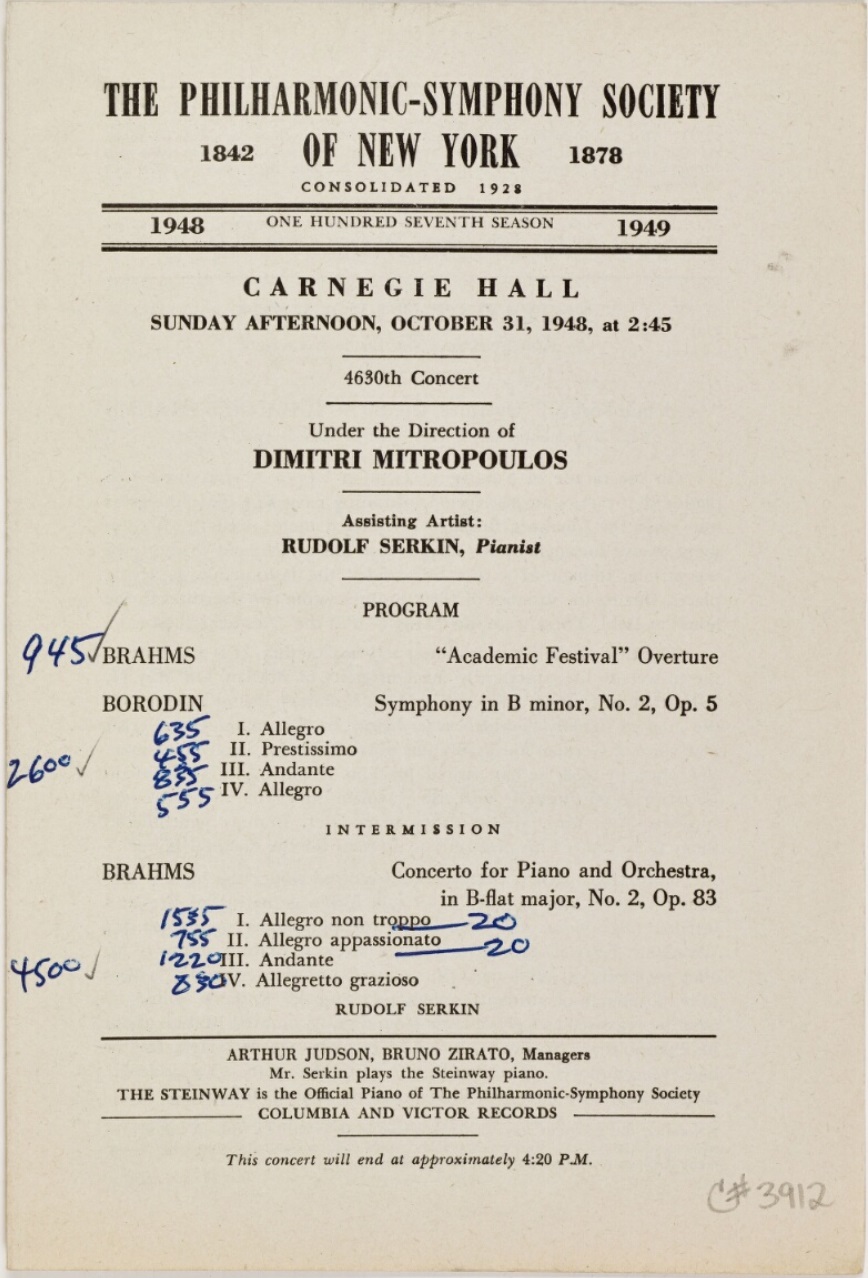
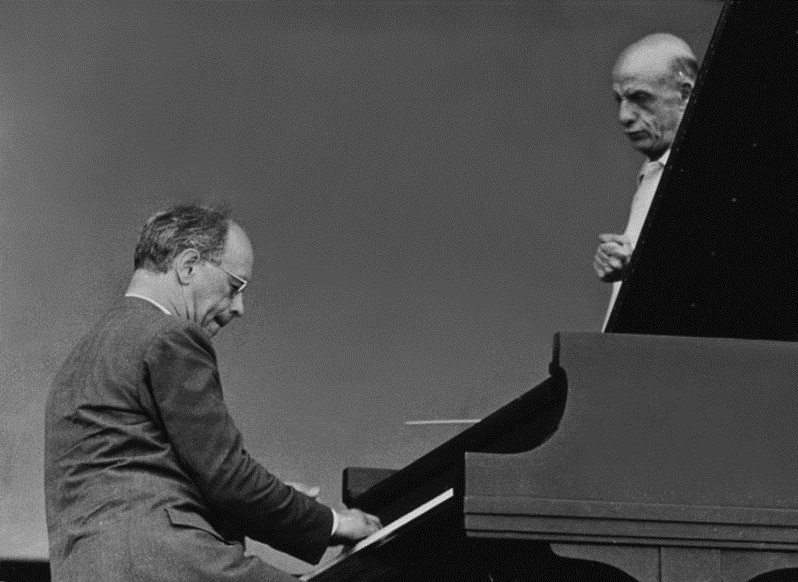
_________________
Between the Concert of February 20, 1936 (Beethoven Concerto n°4 Op.58 & Mozart Concerto n°27 K.595 with Arturo Toscanini) and the « Rudolf Serkin Golden Jubilee Program » of February 20, 1986 (Beethoven Concerto n°4 Op.58 with Zubin Mehta), Rudolf Serkin performed more than 110 times with the NYPO, including 27 Concerts (listed above) under the direction of Dimitri Mitropoulos, but no commercial recording with the latter ever materialized. This rare recording of Brahms’ Second Concerto n°2 (solo cellist: Leonard Rose) represents their first collaboration with the NYPO. The performance has a rare intensity, and for that matter, it is tempting to compare it with the well-known version with Edwin Fischer and Wilhelm Furtwängler, who of course play in a very different style.
(Recorded on 33rpm 16″ Transcription Discs later dubbed on magnetic tape).
_________________
Les liens de téléchargement sont dans le premier commentaire. The download links are in the first comment.
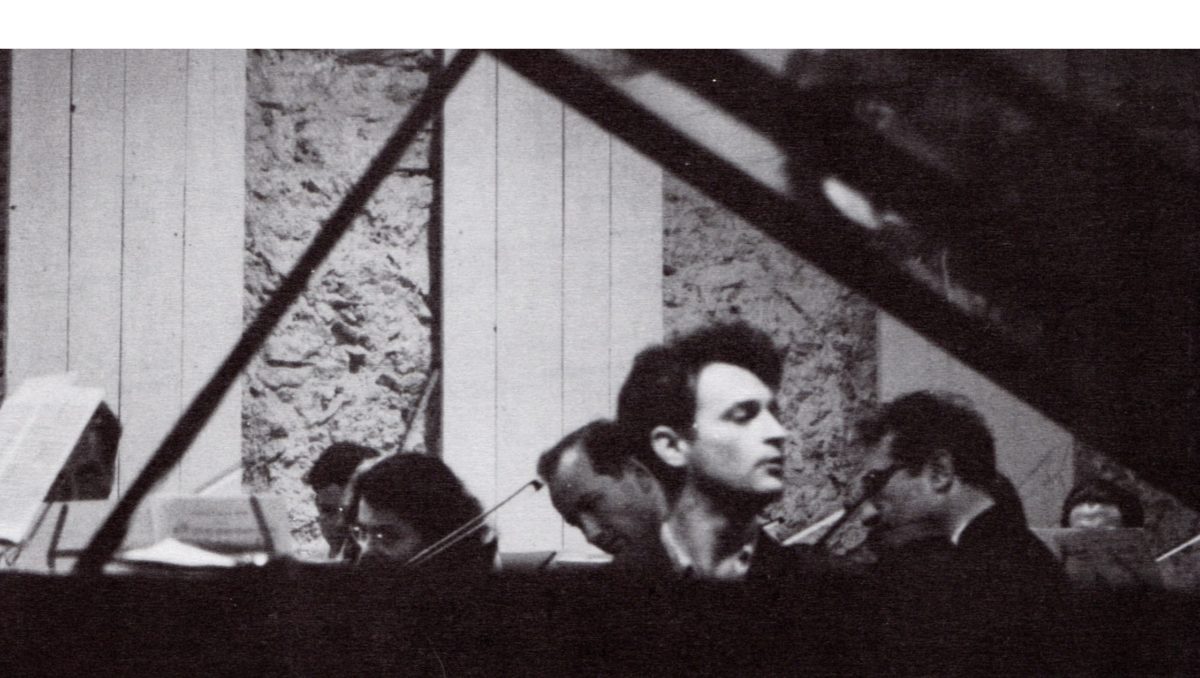
William Kapell – Dimitri Mitropoulos NYPO
Carnegie Hall – April 12 1953
Source: Bande/Tape 19 cm/s / 7.5 ips
La source utilisée jusqu’à présent pour les rééditions de cet enregistrement présente un spectre de fréquences tronqué dans l’aigu, ce qui se traduit par un son quelque peu étouffé qui empêche d’apprécier la splendeur sonore du piano de William Kapell (1922-1953), et aussi de l’orchestre.
La bande recopiée ici est en tout point supérieure et permet de restituer enfin cette grande interprétation que Kapell a donnée pour sa dernière apparition à New York avec un orchestre.

Pour sa dernière saison complète, Kapell a joué à travers les Etats-Unis un ambitieux programme de concertos, avec notamment trois apparitions à New-York, à savoir les 27 et 28 novembre 1952 (avec Dimitri Mitropoulos) pour le Concerto N°17 K. 453 de Mozart qu’il rejouera à Prades l’été suivant sous la direction de Pablo Casals, le 30 décembre 1952 pour le 3ème Concerto de Prokofiev avec le Philadelphia Orchestra (direction Alexander Hilsberg) et enfin les 11 et 12 avril 1953, pour le Concerto n°1 de Brahms, en lieu et place du 3ème Concerto de Prokofiev prévu initialement:
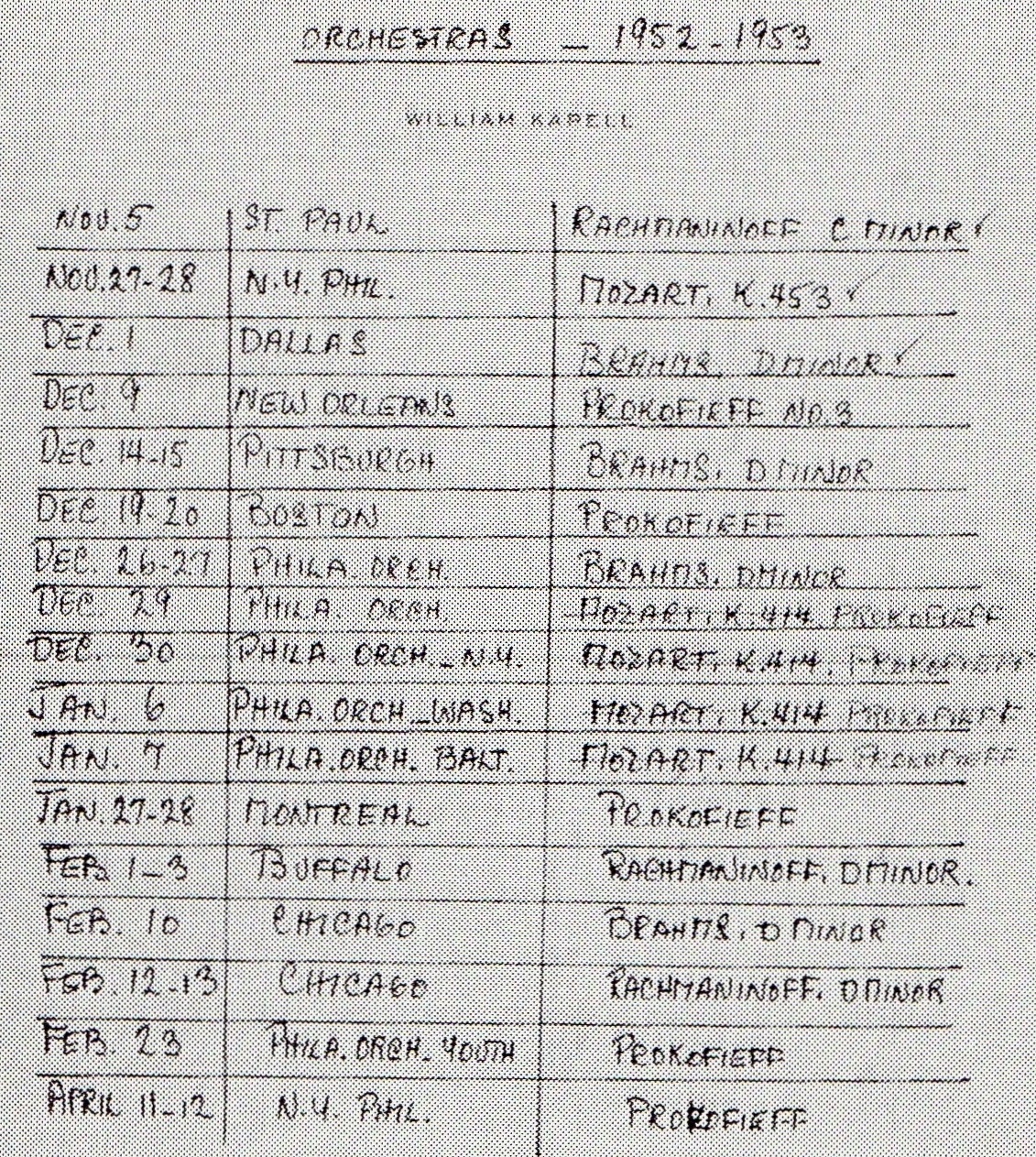
Après le concert du 1er décembre à Dallas avec le Concerto Op.15 de Brahms, le chef Walter Hendl lui a adressé une lettre dans laquelle il écrivait: « I have come to the conclusion that you are the great American pianist » (« J’en suis arrivé à la conclusion que vous êtes le grand pianiste américain »).
Les archives ont conservé des copies annotées des programmes des deux concerts des 11 et 12 avril 1953, et il y a de grandes différences de minutage: le 12, pour le concert radiodiffusé, les premier et deuxième mouvements durent chacun environ une minute de plus.
Nul doute que le pianiste et le chef ont modifié leur approche, probablement lors de la répétition pour le concert du dimanche, qui n’a pas le même programme que le précédent.
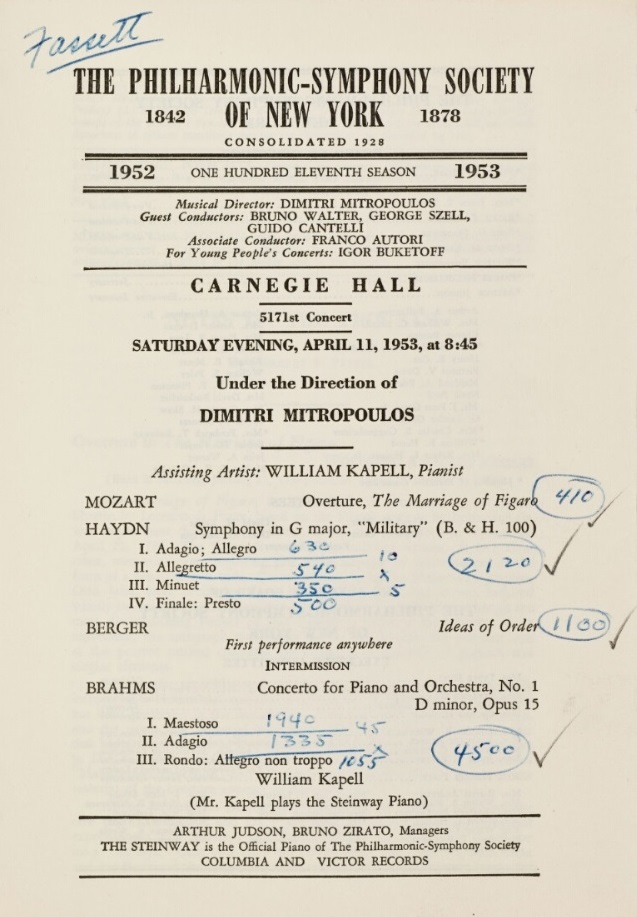

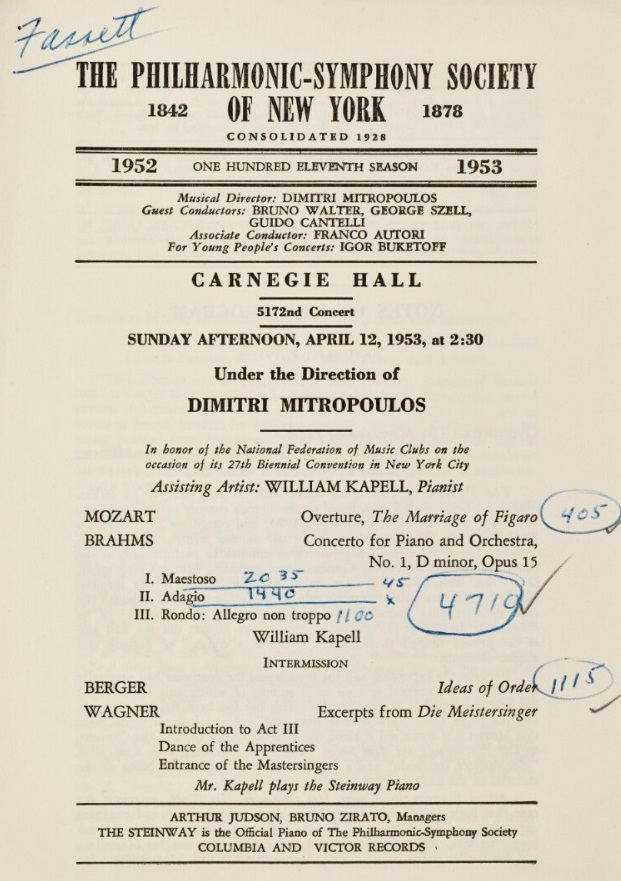
Bien sûr, un minutage différent n’est qu’une vague indication, mais fort heureusement, Harriett Johnson, critique du New York Post a assisté aux deux concerts et nous donne ainsi de précieux commentaires. Ainsi, lors du deuxième concert, l’interprétation était selon elle beaucoup plus détendue et de ce fait beaucoup plus éloquente. Dans ce contexte, elle pointe une tendance du pianiste à se laisser entraîner par sa propre intensité, d’où un excès de tension, une virtuosité trop marquée et une sonorité métallique. L’interprétation de l’Adagio est notée pour son intensité pénétrante, sa vitalité rayonnante et la beauté du phrasé. L’article du Musical Courier (May 1, 1953) va dans le même sens en soulignant, en ce qui concerne le premier concert, la chaleur rhapsodique de l’interprétation, mais aussi le tempo très rapide du premier mouvement, la grande virtuosité et un côté parfois plutôt percussif du jeu du pianiste.
Quoiqu’il en soit, avec ce concert radiodiffusé, nous disposons de la meilleure des deux prestations des interprètes, soliste et chef.
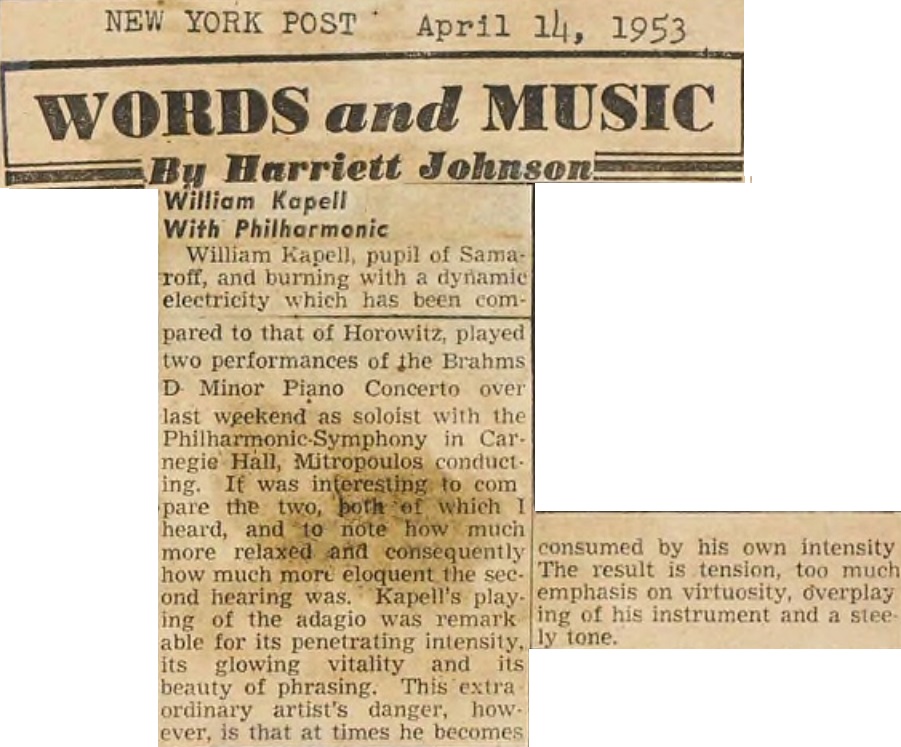
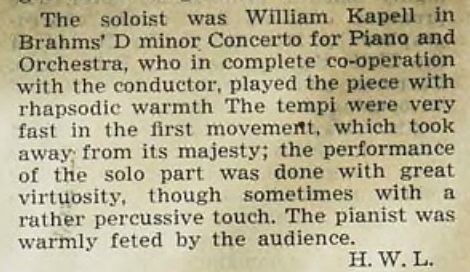
Musical Courier May 1, 1953 (critique du concert du 11 avril)
________________
The source that was used for the previous re-issues of this recording is truncated in the high frequencies, so that the sound is somewhat muffled which does not allow to appreciate the splendid piano sound of William Kapell (1922-1953), and also the orchestra.
The tape dubbed here is vastly superior and fully allows to hear the great performance given by Kapell for his last orchestral concert in New-York.
Fot his last complete season, Kapell performed through the United States an ambitious program of concertos, with no less than three programs in New York, namely on November 27 and 28, 1952 (with Dimitri Mitropoulos) for Mozart’s Concerto N°17 K. 453 he would later perform at the Prades Festival the following summer under the direction of Pablo Casals, on December 30, 1952 for Prokofiev’s Third Concerto with the Philadelphia Orchestra (conducted by Alexander Hilsberg) and to end with, on April 11 and 12, 1953 for Brahms’ First Concerto, instead of the previously scheduled Prokofiev’s Third Concerto.
After the December 1st, concert in Dallas with this Brahms Concerto, the conductor Walter Hendl sent him a letter in which he wrote « I have come to the conclusion that you are the great American pianist ».
The archives have kept annotated copies of the programs of both concerts of April 11 and 12, 1953, and there are major differences in timings: on the 12th, for the broadcast concert, each of the first and the second movements lasts about one full minute longer.
It is clear that both pianist and conductor have reconsidered their approach, probably during the rehearsal for the Sunday concert, whose program is different.
A different timing is of course merely a vague indication, but quite happily, Harriett Johnson, critic for the New York Post attended both concerts and provides us with precious comments. Indeed, at the second concert, the performance was for her much more relaxed and consequently much more eloquent. In this context, she points out the pianist’s tendency toward becoming consumed by his own intensity, the result being tension, too much emphasis on virtuosity, overplaying of the instrument and a steely tone. According to her, the performance of the Adagio was remarkable for its penetrating intensity, its glowing vitality and its beauty of phrasing. The article in the Musical Courier (May 1, 1953) goes in the same direction. It underlines, as far as the first concert is concerned, the rhapsodic warmth of the performance, but also the very fast tempo of the first movement, and the pianist’s great virtuosity and his sometimes rather percussive touch.
Be it as it may, with this broadcast concert, we have the best of the two performances, both for the soloist and the conductor.
Les liens de téléchargement sont dans le premier commentaire. The download links are in the first comment.
